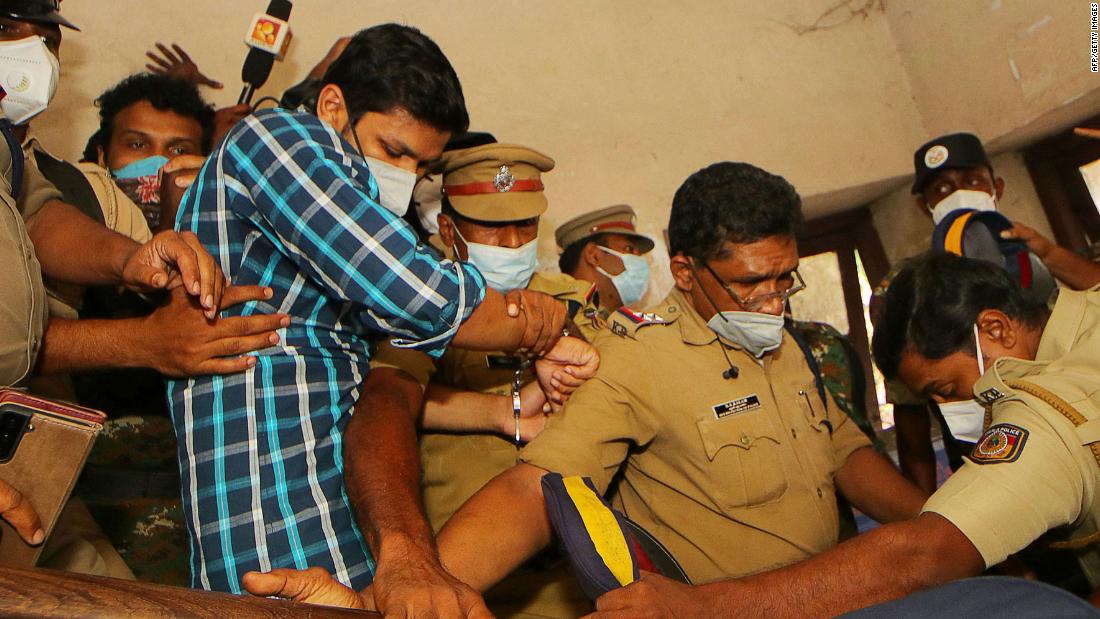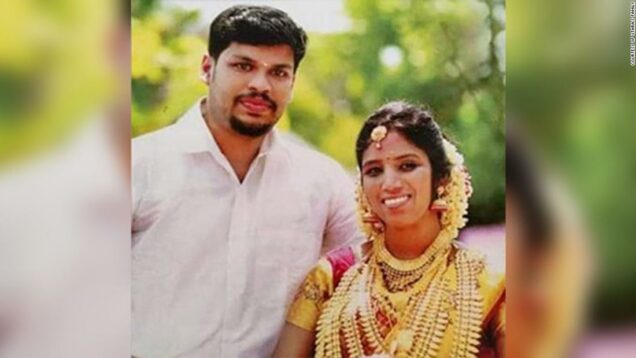22nd November, 2021
An Indian court in the state of Kerala has jailed for life a horrible human being, a man named Suraj Kumar after he killed his wife with a cobra.
It was his third attempt at killing the woman called Uthra, all with snakes.
He had first tried twice to kill her with a viper.
When the attempts failed, he went for a cobra.

This time, he succeeded in killing the 25 year-old woman, mother of his two year-old son.
Uthra’s body lay motionless in bed when she was discovered by her mum at the family home, her left arm dotted with blood.
She was then recuperating from a snake bite organised by Kumar, her so-called husband.
Her family rushed her to the local Kollam hospital in the southern Indian state of Kerala, but she was already dead.
A post-mortem on May 7, 2020, confirmed she’d been bitten hours earlier by a highly venomous Indian spectacled cobra, according to court documents.
In India, where snake bites are not uncommon, that could have been the end of it. But her family grew suspicious and filed a complaint with police.
After a trial that made national headlines, Uthra’s killer was found guilty and sentenced to life in prison for crimes the sentencing judge called “diabolic and ghastly.”
The judge found Uthra’s death was caused by the cobra — but the real killer was her husband.
And it wasn’t the first time he’d used a snake as a weapon.
A broken love story
Suraj Kumar and Uthra, who went only by her first name, met through a matchmaking service and married in March 2018.
“We wanted to find someone who would make her happy,” said Uthra’s brother, Vishu, who also only uses one name. “She was a girl who was a little different. She had a learning disability. We wanted a man who could take care of her.”
Kumar, a 27-year-old bank clerk, did not come from a financially stable background. His father was an auto-rickshaw driver, and his mother, a housewife.
According to the judgment, Kumar married Uthra “with the object of financial gain.”
When the couple married, Kumar accepted a dowry of 720 grams of gold, a Suzuki sedan and 500,000 rupees (about $6,700) in cash.
“Uthra was someone who never saw bad in anyone”
The first few months of married life seemed “uneventful” and within a year they had a son, the judgment said. But it wasn’t long before Kumar’s parents wanted more.
According to the judgment, Kumar’s parents demanded Uthra’s parents pay for household appliances, a car, furniture, renovation work, and admission fees for an MBA course for Kumar’s sister.
“Uthra was someone who never saw bad in anyone,” Vishu said. “Her learning disability meant she didn’t have the means to see that she was being used.”
Uthra’s father told the court he met all of Kumar’s demands and also paid him 8,000 rupees ($107) per month to take care of his daughter.
But Kumar grew “dissatisfied” with Uthra’s learning disability, according to the judgment.
He began to plot her death.
Failed murder attempt
In late 2019, Kumar appeared to develop an obsession with snakes. He spent hours on the internet, watching YouTube videos, including episodes of “Snake Master,” featuring renowned snake expert Vava Suresh.
On February 26, Kumar bought a deadly Russell’s viper from snake handler Chavarukavu Suresh — no relation to Vava Suresh — for 10,000 rupees ($135), prosecutors said.
The next day, he left the snake on the staircase of his house and asked Uthra to fetch his phone from the first floor bedroom, hoping that it would bite and kill her.
“But he failed in the attempt since Uthra saw the snake and raised alarm calls,” according to the judgment.
Kumar captured the snake and kept it in a plastic bag, and on the night of March 2, he tried again.
Kumar mixed sedatives into a sweet bowl of Indian rice pudding before Uthra fell “fast asleep.”
As she slept, Kumar forced the viper to bite her before throwing the serpent out of the house to destroy the evidence.
Uthra woke up screaming in “excruciating pain,” and with some delay she was taken to the hospital by Kumar, who claimed she had been bitten outside at night while washing clothes.
Uthra contradicted his version of events by saying she never did the washing after dusk.
The very next day, as his wife lay in hospital, Kumar was back on his phone researching snakes — but this time he searched for “cobra.”
The murder
Uthra spent 52 days in Pushpagiri Hospital in the Kerala town of Thiruvalla recovering from the viper bite, and when she was finally released to her parent’s care on April 22 last year, she was unable to walk.
As she lay in bed, her leg bandaged after skin grafts, Kumar decided to strike.
On May 6, just 15 days after she had left hospital, he smuggled another snake he’d bought from snake handler Chavarukavu Suresh into her parent’s house. This time it was a cobra.
Before going to bed, Kumar gave Uthra a glass of juice laced with sedatives, according to the judgment. As she slept, Kumar threw the serpent at her, but the reptile didn’t bite, so he grabbed its head and forced its fangs deep into her left arm — twice.
Despite his efforts to make it appear as an accident, a number of clues suggested the bites weren’t natural — from the width of the fang marks, to the position of the bites, and the impossibility that the cobra had entered the room on its own.
“Cobras generally do not bite unless they are highly provoked. And after 8 p.m. they’re generally dormant”
The two pairs of bite marks on Uthra’s arm had a width of 2.3 and 2.8 centimeters (0.9 and 1.1 inches) respectively, much larger than the typical width of cobra fangs of between 0.4 to 1.6 centimeters (0.16 to 0.63 inches), experts told the court.
That indicated the cobra’s upper jaw had been pushed as if it was being milked.
The time of day also raised suspicion.
“Cobras generally do not bite unless they are highly provoked. And after 8 p.m. they’re generally dormant,” said Hari Shankar, an assistant inspector general at Kerala Police, who worked as lead investigator on the case.
In court, investigators demonstrated their argument by setting up an experiment to demonstrate whether a cobra would strike a sleeping person.
In the video, the same type of cobra was thrown on a bed with a mannequin at night. The video shows the snake slithering away several times and only biting into a chicken breast tied to a limb when repeatedly provoked.
Investigators threw another cobra on a mannequin to see how it would react.
Experts also raised doubts over how the cobra came to be in Uthra’s room.
Cobras can only raise themselves vertically to one-third of their length, the court was told, meaning the 152-centimeter (60-inch) cobra that bit Uthra could only have raised itself to a height of around 50 centimeters — not high enough to enter through the windows. Three air holes in the room were also sealed.
And lastly, Uthra had slept through what was arguably one of the most painful experiences of her life.
Kumar pleaded not guilty to the charges, but the judge convicted him of four offenses, including attempted murder and murder, and he was given two life sentences.
Read the rest in CNN



